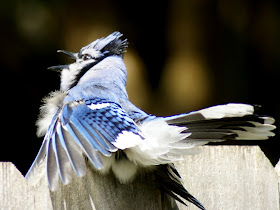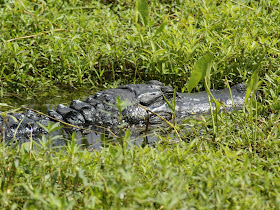.
The past week has been really hot here in southeast Texas, with highs getting pretty close to the 100F mark. We've been avoiding the heat and enjoying our air-conditioning but our birds have been suffering.
It has been toughest for the young birds, the ones born this spring and early summer. The juvenile Blue Jays have coped by puffing up their feathers to provide insulation from the heat but they haven't looked or sounded too happy about it.
Our young male and female Northern Cardinals have been looking stressed, too.
Their parents haven't looked like they're handling the heat much better.
Our White-winged Doves think that fanning out their wings and tails is the answer.
At least one of our Blue Jays has been trying out the same technique.
One odd thing about this is that our backyard is so small that the birds are never more than a few yards from a birdbath, which we keep full. The birds know it's there because lots of them come and drink from it. However, only one bird - a Blue Jay - seems to have taken full advantage of during the current heatwave.
.
.
I'm afraid I'm still finding it difficult to make time for birding, which is why I haven't been posting as often as usual. However, Dee and I did make it to Paul Rushing Park for an hour on Suday morning.
I had promised Dee that she would see Common Nighthawks in the park and, sure enough, a couple were sitting on fences when we arrived.
As usual, Eurasian Collared-Doves were perched on the higher fences.
The ponds were quiet for birds except for a pair of Pied-billed Grebes on the water and a few large waders (Great and Snowy Egrets and a Great Blue Heron). The observation deck railings were attracting lots of birds, though, including Cave Swallows, Red-winged Blackbirds, a Green Heron (below) and a Little Blue Heron (below).
I didn't bother taking photos of the Killdeer that were everywhere but a Loggerhead Shrike caught my eye because it looked like a juvenile. (If so, it's the first juvenile Shrike that I've seen in years.)
On our way home, we did a quick drive along Longenbaugh and Porter Road End, in hopes of getting good looks at some Scissor-tailed Flycatchers. As always in summer, there were plenty! Most were on utility wires.
However, a few were handing out (with Eastern Kingbirds) in the hedges.
Longenbaugh had more Northern Mockingbirds than you could shake a stick at, and it also had numerous Loggerhead Shrikes. As at Paul Rushing Paul, one of the Shrikes appeared to be a juvenile.
The utility wires over the Bear Creek bridge on Longenbaugh were crowded with dozens of swallows. These looked to me to be Cliff Swallows and mainly juveniles but don't hesitate to correct me if I'm wrong!
.
.
Saturday we headed over to Brazos Bend State Park. We've visited this park so often over the years that it feels like an old friend. We meant to go there several weeks ago but the park was closed because of flooding and it did not re-open until last Wednesday.
While there wasn't much sign of flood damage on the main trails we explored, many of the smaller trails were closed.
Forty Acre Lake was partly obscured by water lilies (below) and invasive water-hyacinth.
Perhaps because the recent floods had displaced them, birds were few and far between both on the lake and in the wetland areas immediately next to it. Yellow-crowned Night Herons were present, though, including several juveniles (below).
For the first time ever we noticed that the trees well back from the 40 Acre Lake trail were full of large nests. Many of scores of visible nests belonged to Cattle Egrets but many others were occupied by White Ibis (below).
The occasional young White Ibis wandered across the trail ahead of us.
Alligators were fairly scarce. We saw only five on or around the lake.
Red-eared Sliders were, of course, plentiful and I enjoyed getting down to photograph this one's face.
Creekfield Lake was as beautiful as ever. Unfortunately, though, I couldn't spot a single bird there. Even the scores of Black-bellied Whistling Ducks and Black Vultures that normally hang out there had vanished, presumably displaced by the flooding to another part of the park or the surrounding countryside.
Elm Lake was a little busier, although there certainly weren't anything like as many birds there as usual. Of course, here like at 40 Acre much of the surface was covered with vegetation.
I explored one corner of the lake and scared up a couple of Cattle Egrets, which flew off before I could photograph them. A Black-bellied Whistling Duck was less skittish.
A Little Blue Heron also ignored my presence.
A Purple Gallinule beat a hasty retreat. I'm not sure if two chicks in the same area belonged to the Purple Gallinule or whether they were the offspring of a Common Galinule that was hiding in the vegetation.
A little further along the Elm Lake trail I came across a pair of Common Gallinules (formerly Common Moorhens) that seemed to be doing nothing much at all.
It took a couple of minutes before I realized that they were keeping their eyes on their two young chicks, who were exploring among the lily-pads nearby.
As birds were comparatively scarce and the weather was hot and sticky, we only spent two hours in the park on this trip. No doubt we'll be back there later in the year for a longer visit.
.
.
Herons were comparatively scarce around Shovelers' Pond. We had a brief glimpse of a Green Heron in flight and a partial view of a Great Blue Heron grooming.
This Tricolored Heron was one of only three we spotted.
If Herons were scarce, Egrets were present in numbers. Cattle Egrets were particularly numerous and we probably saw well over a hundred.
White-faced and White Ibis (below) were common also.
I was half-hoping for my first Wood Storks of 2015 and was rewarded when two flew over in the distance.
Apart from Gallinules and Pied-billed Grebes, there were few birds on the water. A handful of Black-bellied Whistling Ducks were too far away for photos but two Fulvous Whistling Ducks were much nearer.
Orchard Orioles and Eastern Kingbirds popped up in several places around Shovelers' including at the Willows.
We had our picnic lunch in the old Visitor Center. The refuge staff have taken measures to prevent Barn and Cliff Swallows from nesting inside the old VC building. They seem to have largely succeeded as far as Barn Swallows go but a dozen or more pairs of Cliff Swallows had still managed to construct nests.
After lunch we drove a short way down the road towards Frozen Point, as I wanted to look for Common Nighthawks and Dickcissels.
The fence posts had six Common Nighthawks, as well as many Red-winged Blackbirds.
We hadn't gone far before we also turned up a couple of Dickcissels, my first of the year.
Our final sighting was of a Scissor-tailed Flycatcher on a utility wire.
.

























































